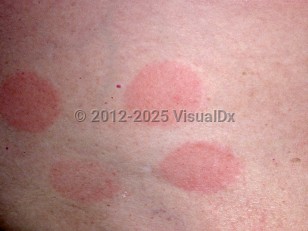Allergic contact dermatitis - Nail and Distal Digit
See also in: Overview,Cellulitis DDx,External and Internal Eye,Anogenital,Hair and Scalp,Oral Mucosal LesionAlerts and Notices
Important News & Links
Synopsis

Contact dermatitis of the nail unit may be either irritant or allergic, and allergic contact dermatitis (ACD) comprises 20% of contact dermatitis cases of the nail. ACD of the nail apparatus commonly involves the proximal nail fold (PNF) and the hyponychium, and may cause both skin changes and nail plate abnormalities. Onycholysis is the most common nail change. Other nail findings include pitting, Beau lines, and onychodystrophies. These changes are caused by involvement of the adjacent proximal nail matrix. Hyponychium involvement results in severe subungual hyperkeratosis and nail bed splinter hemorrhages.
There are multiple causes of ACD of the nails. A careful history can elicit allergens that commonly come into contact with the fingers. Workers in certain occupations, such as hairdressers, manicurists, dental workers, fiberglass workers, printers, and glue workers, are at high risk for developing irritant contact dermatitis as well as ACD.
Common allergen-containing products include sunscreens (oxybenzone [benzophenone-3]), cosmetics, soaps, and dyes. Other allergens include epoxy resins (previously recognized for occupational exposure but now also commonly used in recreational activities and hobbies), essential oils (due to terpenes), methylisothiazolinone (a preservative in cosmetics and household products), and (meth)acrylates (nail cosmetics).
A history may elicit exposure to long-lasting nail polishes containing methacrylates. Methacrylates can also be found in dental products and hard plastics. Formaldehyde, which is found in nail hardeners, is another cause of ACD. Foods can rarely cause ACD. Efinaconazole can also cause ACD.
In 2019, isobornyl acrylate was named the Allergen of the Year by the American Contact Dermatitis Society. It is an acrylic monomer often used as an adhesive. Acrylic nails are a potential source. Clinician awareness is important because tests using routine panels do not identify isobornyl acrylate. Other recent examples of Allergen of the Year include toluene-2,5-diamine sulfate (PTDS) (2025), sulfites (2024), lanolin (2023), and aluminum (2022).
Related topics: hand dermatitis
Codes
L23.9 – Allergic contact dermatitis, unspecified cause
SNOMEDCT:
40275004 – Contact dermatitis
Look For
Subscription Required
Diagnostic Pearls
Subscription Required
Differential Diagnosis & Pitfalls

Subscription Required
Best Tests
Subscription Required
Management Pearls
Subscription Required
Therapy
Subscription Required
Drug Reaction Data
Subscription Required
References
Subscription Required
Last Updated:08/10/2025
 Patient Information for Allergic contact dermatitis - Nail and Distal Digit
Patient Information for Allergic contact dermatitis - Nail and Distal Digit- Improve treatment compliance
- Reduce after-hours questions
- Increase patient engagement and satisfaction
- Written in clear, easy-to-understand language. No confusing jargon.
- Available in English and Spanish
- Print out or email directly to your patient


